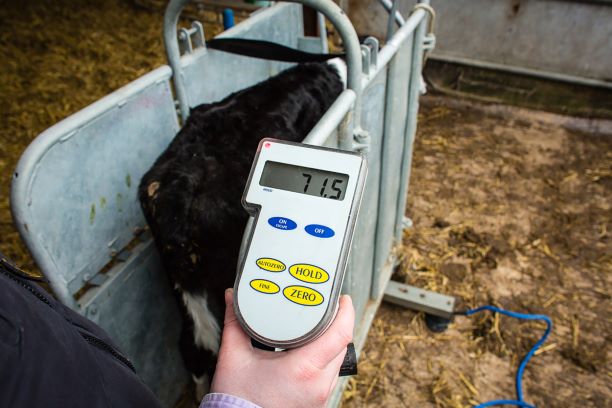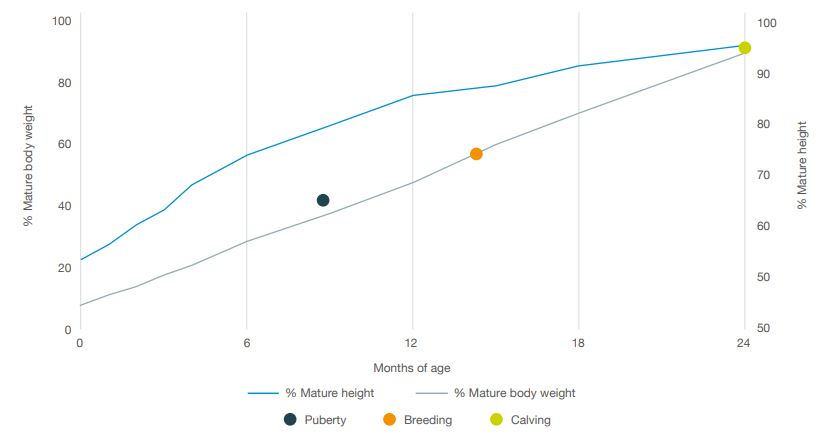- Home
- Knowledge library
- Monitoring dairy calf growth
Monitoring dairy calf growth
Measuring youngstock growth rates provides useful information about how well they are growing. It is also an indirect method of monitoring feed conversion efficiency
Back to: Dairy calf growth rates
Benefits of monitoring growth
Meeting growth rate targets ensures maximum return on your investment.
- Achieve target growth rates for breeding
- Identify underperforming and sick calves
- Identify problems within your system (e.g. poor housing)
- Maximise efficient growth, cost-effectively
Top tips
- Growth is at its most efficient in the first two months of life, so high growth rates should be targeted during milk feeding
- Monitoring growth from birth guides regular management improvements to make sure every heifer is in calf by 15 months of age
Monitoring by weight
Electronic scales, as shown below, are the most accurate method of determining weight. A set of weigh bars with a strong platform will suffice. Using this in combination with a race will be good training for handling in later life.
You can also use a weigh band to estimate weight, placing it around the calf’s girth, behind the front leg and shoulder blade. Place it flat against the skin and hold at a consistent tightness, ensuring it is not twisted.

Monitoring by height
Measure calf height using a height stick placed across the withers or rump when the animal is standing on a flat surface. Alternatively, make use of fixed height markers on the wall of the building. But if you do this, make sure you account for any change in bedding height that may occur.
When to measure growth rate
Growth rate can only be calculated when at least two measurements have been made. Recording the calf’s birth weight provides a baseline figure against which to calculate the average daily gain (ADG), also known as daily liveweight gain (DLWG).
Then measure again, as regularly as possible, at:
- Weaning
- One week post-weaning
- Six months of age
- At breeding
Taking a measurement at six months gives you time to correct any problems before breeding.
Example calculation of growth rate
A calf has a birth weight of 38 kg.
One month later, it weighs 62.5 kg.
Use the average daily gain calculation below to work out the daily gain for this calf:
Finish weight - Start weight = Daily liveweight
Age (days) gain (kg/day)

Target growth rates
The key to successfully rearing heifers for calving at 24 months is to maximise weight gain without creating overfat heifers. Research and experience confirm that heifer growth rates are best set as a percentage of mature weight, or size.
It is important to base your targets on a percentage of mature size (weight or height) of several third- and fourth-lactation cows in the herd that are 100–120 days in milk.
Remember, it does not matter which method you use to monitor growth, if you take regular measurements from your own animals using the same method each time. This allows you to benchmark your herd performance between groups.
The table below shows the percentage mature weight to target at different stages, using an average mature body weight of 685 kg. The target height for the different stages is also shown.
Decide the most appropriate intervals to weigh your heifers for your farm. If you find that growth rates are too low, consult your nutritionist or vet for advice.
| Age | Stage | Body weight (kg) | % Mature weight | % Mature height |
|---|---|---|---|---|
| 0 | Birth | 41 | 6 | |
| 1 | 55 | 8 | ||
| 3 | Post-weaning | 116 | 17 | 63 |
| 6 | 185 | 27 | 74 | |
| 9 | Puberty | 274 | 40 | |
| 12 | 343 | 50 | ||
| 14 | Pre-breeding | 377 | 55 | 87 |
| 24 | Pre-calving | 582 | 85 | 96 |
| MW | Adulthood | 685 | 100 |
The graph below shows how the target percentage differs depending on whether using mature body weight or height as the guide.

Useful links
To order a hard copy of the Calf management guide contact publications@ahdb.org.uk or call 0247 799 0069.
Sectors:

